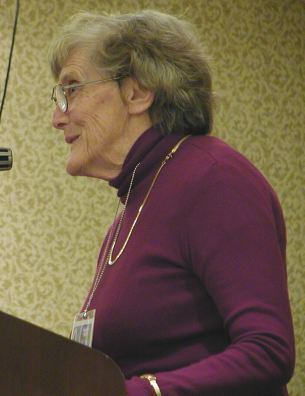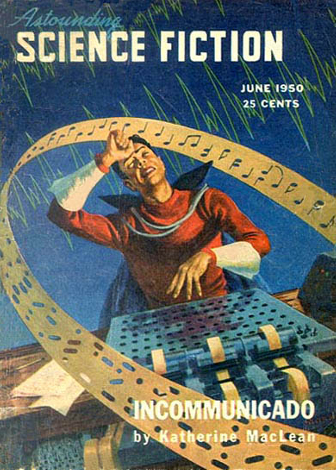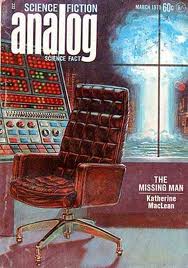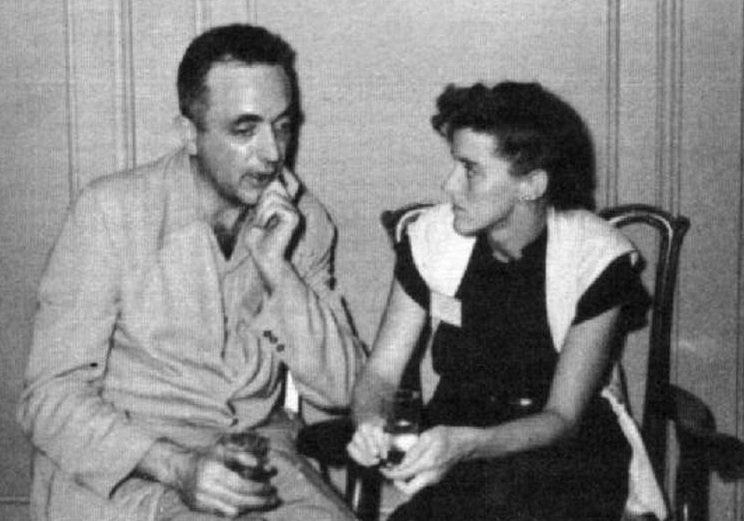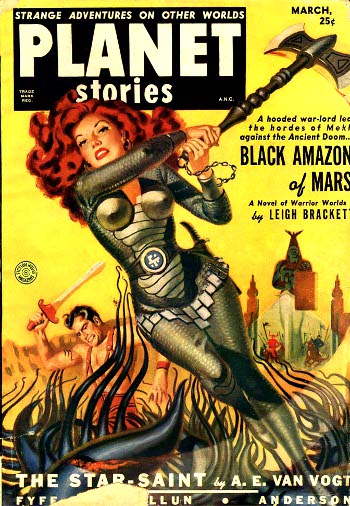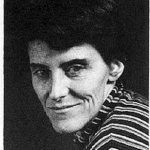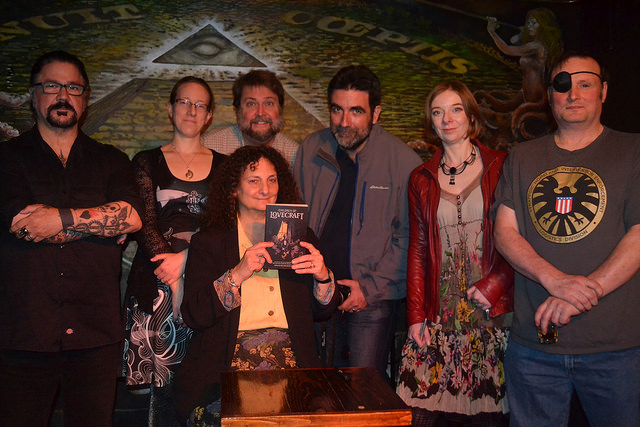(1) WHAT YOUNG PEOPLE THINK OF MACLEAN. James Davis Nicoll’s Young People Read Old SFF returns with the panel’s responses to “Unhuman Sacrifice” by Katherine MacLean. Mikayla and the other young hands weigh in.
Katherine MacLean (1925 – 2019) was active as a short story writer mainly in the 1950s (although pieces appeared as late as 1997) and as a novelist mainly in the 1970s. Her Second Game saw her a Hugo finalist in 1959; Missing Man won a Nebula in 1972. Rediscovery offers MacLean’s “Unhuman Sacrifice”, an uplifting tale of a human missionary convinced he knows best for a community of just-contacted aliens. No doubt it can only end well.
The plan for this phase of Young People was to shift to a conversation-based format, using Slack to facilitate discussion. I then sabotaged this by getting sick the week the reviews came in. Ah, well. Next time it will all work swimmingly.
(2) MANY CHEFS. Daniel Brotzel’s SFWA Blog post “Collaboration” includes this advice for making it work:
…Writing a book with someone else can be a nightmare or it can be pure pleasure. In our case, lots of things fell into place almost by accident, things which I can now see are essential to making a collaboration work. These include:
• a shared passion for the project and the idea
• mutual respect for each other’s writing and ideas
• a practical way of working that can accommodate everyone’s schedules and constraints
• a willingness to set egos aside and make compromises for the good of the project (and the ultimate benefit of the reader)
• an attitude that embraces sharing and the ambition to see things through
• a good blend of the skills and capabilities that you to get a book off the ground – and beyond
(3) ANIMANIACS. SYFY Wire confirms the “Animaniacs Cast Will All Return”.
Almost a full year ago we found out that the Animaniacs will be revived on Hulu with Steven Spielberg executive producing. And that was pretty exciting. But the larger question hung in the air: What about the original cast?
Well you can breath easy: They’re all back. Yes, Rob Paulsen, Jess Harnell, Tress MacNeille, and Maurice LaMarche are all returning to the fold. Or the water tower, I guess. It’s a massive relief. It’s not that animated characters can’t be recast, it’s just that these specific actors are, frankly, a pure distillation of so many childhoods that it would be a shame if they weren’t all returning to Animaniacs. Hooray! Everyone likes good news!
(4) WHO’S AFRAID OF THE BIG BAD AMAZON? amNY reveals “The secret to The Mysterious Bookshop’s 40-plus years of success”.
…Book clubs also keep loyal readers inspired, including a Book of the Month subscription that includes a signed first edition of the shop’s choosing and an unclassifiable club that includes books that do not fall into the traditional mystery genre. For example, Rob Hart’s “The Warehouse,” which takes place in a near-future dystopian world where a company has become a totalitarian force, would not traditionally be shelved in a bookstore’s mystery section, but has been extremely popular in The Mysterious Bookshop.
Speaking of corporate monopolies, Penzler isn’t fearful of big box competitors.
“We can compete with Amazon because they don’t offer signed books,” he says. “I shouldn’t say that so loudly because they’ll probably do it, but every mystery writer comes to sign at our store. Half of books sold are signed and we don’t charge more for them!”
(5) ONE IS ENOUGH. NPR’s Mark Jenkins pans both performances: “Clone Gunman: Will Smith Vs. Will Smith In Sluggish, Sterile ‘Gemini Man'”.
Long before digital imaging, German philosopher Walter Benjamin opined that reproductions of artworks lacked the “aura” of the original. But what about reproductions of people? To judge by Will Smith’s double act in Gemini Man, the forerunner can be just as lacking as the copy.
Conceived more than 20 years ago as a Tony Scott-directed action flick, Gemini Man eventually fell to Ang Lee, who has recently shown more interest in cinematic technology than storytelling. Once a versatile stylist, the Taiwan-born director of The Life of Pi now seems consumed by advances in CGI. His latest trick, casting Will Smith against a digitally backdated version of himself, can’t save this movie from being bland, sluggish, and sentimental.
…There’s something else that Gemini Man shares with The Da Vinci Code: clunky dialogue. Credited to three writers but reportedly the work of many more, the movie’s script offers a preposterous scenario that might have been finessed by visual and verbal wit. It has little of either….
(6) THE NEED FOR SPEED. Leonard Maltin, on the other hand, was won over by the technical virtuosity as he says in the beginning of his review “Gemini Man: Two Will Smiths For The Price Of One”.
I was wary approaching Gemini Man, which I saw at 120 frames per second (about four times normal film speed) in 3-D. I got a headache the last time I watched a high-frame-rate feature but I came away from this film a believer. Director Ang Lee is trailblazing new territory, as he did in Billy Lynn’s Halftime Walk, but this time he has a highly enjoyable, action-packed story and a perfect star in Will Smith. The entertainment value is high and cutting-edge technology organically suits the content….
(7) INSIDE THE CANISTER. Alasdair Stuart says this is what readers of “The Full Lid 11th October 2019” have in store:
This week’s Full Lid soars above London with the parkour and violence enthusiasts of the Assassins Creed Symphony! Then I’m off to Sheffield to discover my new favorite poem at an event that celebrates science and art and where they mix. This piece genuinely left me speechless and I’ve been riding an endorphin wave from being able to see it all week.
Finally, I take a look at Swedish SF movie Aniara, adapting the epic poem and Horror Christmas reaches The Silence of the Lambs. If you like what you read, please share and subscribe and I’ll see you next week. Happy Friday, everyone!
(8) PEN OUT LOUD. In a wide-ranging conversation with author Marlon James, acclaimed writer and former PEN America President Salman Rushdie previewed his latest novel Quichotte, a modern take on Miguel de Cervantes’ 17th-century novel Don Quixote, at a PEN Out Loud evening in New York City. There’s also a transcript at the link: “Salman Rushdie and Marlon James Discuss Language, Reality, and Nostalgia at PEN Out Loud”.
RUSHDIE: Intimate, but you know, [English is] not my mother tongue. That’s to say. I grew up in a kind of environment in India where everybody’s kind of multilingual because you have to be. But basically the language we spoke at home was mostly not English, mostly Urdu. But I went to what they call an English medium school. So when I went to school, I was being taught in English. So I grew up more or less bilingual. One of the reasons that I never make a spelling mistake is because I had to learn the language. People who just have the language very often can’t spell.
JAMES: Yes, when you said that, I heard my high school teacher in the back of my head going “dot your i’s, cross your t’s, and leave a full stop by the end of every single sentence.”
RUSHDIE: Yes, exactly. We got taught that shit.
JAMES: Yes, but I remember for a long time my biggest struggle with writing in English is, I would put something down, or I’ll speak, and it took me a while to realize I sounded like the butler.
RUSHDIE: Like a butler?
JAMES: Yeah. Like it was a very colonial English.
RUSHDIE: Like Jeeves.
JAMES: Yeah.
RUSHDIE: I can’t imagine you writing, the books you’ve written, as if you were Jeeves.
JAMES: I’m telling you, I used to use shit like “betwixt.”
(9) LEONOV OBIT. Cosmonaut Alexei Leonov, the first to walk in space, died at the age of 85 on October 11. CollectSpace paid tribute:
…Selected alongside Yuri Gagarin among the first 20 Soviet Air Force pilots to train as cosmonauts in 1960, Leonov flew twice into space, logging a total of 7 days and 32 minutes off the planet.
Launched on Voskhod 2, the world’s 17th human spaceflight, on March 18, 1965, Leonov made history as the first person to exit his spacecraft for an extravehicular activity (EVA).
“The Earth is round!” he exclaimed, as he caught his first view of the world. “Stars were to my left, right, above and below me. The light of the sun was very intense and I felt its warmth on the part of my face that was not protected by a filter,” said Leonov in a 2015 interview with the Fédération Aéronautique Internationale (FAI) on the 50th anniversary of his spacewalk.
The New York Times obituary tells how that mission was almost fatal for Leonov:
…What Mr. Leonov did not reveal until many years later was that he and his fellow cosmonaut, Pavel I. Belyayev, who was also an Air Force pilot, were fortunate to have survived.
Mr. Leonov’s specially designed suit had unexpectedly inflated during his walk, and its bulk was preventing him from getting back inside the Voskhod.
“I knew I could not afford to panic, but time was running out,” he recalled in the book “Two Sides of the Moon” (2004), written with the astronaut David Scott, about their experiences in space.
Mr. Leonov slowly deflated the suit by releasing oxygen from it, a procedure that threatened to leave him without life support. But with the reduced bulk, he finally made it inside.
“I was drenched with sweat, my heart racing,” he remembered.
But that, he added “was just the start of dire emergencies which almost cost us our lives.”
The oxygen pressure in the spacecraft rose to a dangerous level, introducing the prospect that a spark in the electrical system could set off a disastrous explosion or fire.
It returned to a tolerable level, but the cosmonauts never figured out the reason for the surge.
When it came time for the return to Earth, the spacecraft’s automatic rocket-firing system did not work, forcing the cosmonauts to conduct imprecise manual maneuvers during the descent that left them in deep snow and freezing temperatures in a remote Russian forest, far from their intended landing point.
(10) PITTS OBIT. The SFWA Blog noted the death of J.A. Pitts:
SFWA member John A. Pitts died on October 3 from amyoidosis. Pitts began publishing short fiction in 2006 with “There Once Was a Girl from Nantucket (A Fortean Love Story),” co-written with Ken Scholes. He went on to write several short stories on his own and in 2010 began publishing novels under the name J.A. Pitts with Black Blade Blues, the first novel in his series about Sarah Beauhall.
(11) TODAY IN HISTORY.
- October 11, 1957 — The Black Scorpion debuted. Starring Richard Denning, Mara Corday and Carlos Rivas, Rotten Tomatoes gave it a 33% rating. Mystery Science Theater 3000, well, see for yourself here what they thought of it.
(12) TODAY’S BIRTHDAYS.
[Compiled by Cat Eldridge.]
- October 11, 1921 — Linda Stirling. Sheila Layton in the 1945 The Purple Monster Strikes serial, also known as D Day on Mars. The sequel to this serial was the 1950 Flying Disc Man from Mars, which simply recycled much of the footage from the original. (Died 1997.)
- October 11, 1940 — Caroline John. Liz Shaw, companion to the Third Doctor. Shaw was a brilliant scientist, unusual for a companion. She returned for The Five Doctors. And she would reprise her character in the Big Finish audio works. Later she played the role of Laura Lyons in the BBC adaptation of The Hound of the Baskervilles, opposite Tom Baker as Holmes. (Died 2012.)
- October 11, 1960 — Nicola Bryant, 59. Well known for her role as Perpugilliam “Peri” Brown, a companion to both the Fifth and Sixth Doctors. She also worked in “The Two Doctors” story so she appeared with the Second Doctor as well. Of course she’s done Big Finish Doctor Who audio dramas.
- October 11, 1965 — ?Sean Patrick Flanery, 54. I really think that his best work was on The Young Indiana Jones Chronicles and the films that followed.
- October 11, 1972 — ?Claudia Black, 47. Best known for being Aeryn Sun in Farscape, Vala Mal Doran in Stargate SG-1 and Sharon “Shazza” Montgomery in Pitch Black. She also had a recurring role as Dahlia in The Originals and starred as Dr. Sabine Lommers in The CW’s Containment series.
- October 11, 1976 — Emily Deschanel, 43. Temperance “Bones” Brennan in Bones which crossed over with Sleepy Hollow twice (she visited the latter once) and she had a bit part on Spider-Man 2. More notably she was Pam Asbury in Stephen King’s Rose Red series.
- October 11, 1985 — Michelle Trachtenberg, 34. Dawn, one of the most annoying characters in television ever, on Buffy the Vampire Slayer.
(13) NANCY. A Slate Q&A with Olivia Jaimes reveals “Nancy’s Artist Revived an 80-Year-Old Comic Strip by Writing Fan Fiction”
Matthew Phelan: Is working with someone else’s characters emotionally freeing? Or do you feel an intense, world-historic duty to do justice to classic Nancy?
Olivia Jaimes: It feels like I’m writing Nancy fan fiction, which is very freeing. I’ve said the same thing to my editor before, and she’s gently broken it to me that my Nancies are canon, but fan fiction is what it feels like nonetheless. Maybe what I mean by this is that I feel comfortable transforming the strip in ways that suit me because I trust readers to know “the rules” of transformative works like fan fiction. It’s your take on characters that are shared by everyone. You’re not trying to pass seamlessly as the original author; you’re stretching and bending the original work to make it say what you want it to say.
(14) FLASH REFERENCES FLASH. [Item by Daniel Dern.] Am I the only one who (a) couldn’t tell what the words were, in the episode, (b) wouldn’t have recognized this as a Queen tune, even if I had, nor necessarily which movie it was from, (c) don’t mind, since, if nothing else, Cisco (formerly “Vibe”) had “been waiting for the perfect moment to use it, and Caitlin (aka Killer Frost) recognized it. Io9’s James Whitbrook’s episode recap “The Flash Finally Did It” explains:
… And, via Cisco, The Flash finally, finally does something that is incredibly goofy, completely rad, and something it has simply been yearning to do since it first began: Cisco taps a key on STAR Labs’ sound system.
And Queen’s Flash Gordon theme starts playing.
It’s so dumb. It’s so good. It is, as Cisco argues, the perfect moment to deploy the 1980 classic. You don’t care that the black hole CG comes with all the questionable success CW-budget computer effects usually bring. You don’t care that this has been, otherwise, a pretty humdrum episode of The Flash, and weirdly low key for a season premiere. This is what this show has always been, and hopefully always will be, about: embracing the sheer, kinetic, camp audacity of superhero comics and just having an absolute whale of a time while doing so.
(15) SAILOR SHIPPING OVER. ScienceFiction.com says “Sailor Moon Is Returning To The Big Screen In 2020 In ‘Bishoujo Senshi Sailor Moon Eternal’”.
(16) GAMES TRANSFORMED TO NARRATIVES. “Ubisoft Planning Animated TV Adaptations of Popular Game Franchises” – The Hollywood Reporter has the story.
Video game giant Ubisoft is getting cartoonish.
The Paris-based company’s film and television division is developing a slate of animated series inspired by its existing IP. First up: a Mars-set Rabbids Invasion special, after four successful seasons of the France 3/Netflix/Nickelodeon kids show. Other family-friendly programs in the works include a comedy-adventure inspired by the popular Rayman franchise and Hungry Shark Squad, based on the mobile game Hungry Shark.
… For slightly older viewers, Ubisoft is toning down its M-rated Watch Dogs action-adventure franchise for a tamer “cybermystery” aimed at tweens. The show centers on a teenaged “super hacker” who solves crimes in her high school.
(17) CHINA’S PROXY CENSOR. Zack Beauchamp, in “One of America’s Biggest Gaming Companies Is Acting As China’s Censor” on Vox, says that Activision Blizzard banned Chung Ng Wa, who plays as “Blitzchung,” after he won a Hearthstone Grandmasters tournament and then put on goggles and a face mask and said, “Liberate Hong Kong, revolution of our time.”
On Tuesday, Blizzard came down hard on Chung. In an official statement on Hearthstone’s blog, the company announced that it would be suspending Chung for a year, forcing him to forfeit thousands of dollars in prize money from 2019 and firing the casters (commentators) who conducted the interview.
This is a big deal.
Blizzard, who created (among other things) World of Warcraft, is a massive company. It brought in about $7.5 billion in revenue in 2018. Like the NBA, which has rebuked the Houston Rockets’ general manager over a pro-Hong Kong tweet, Blizzard is not merely trying to operate within the confines of Chinese censorship but acting as its agent.
(18) HEY, THE TIMING IS NOT THE ROBOT’S FAULT. “Istanbul Airport Robot Has A Message for You!” on YouTube describes the friendly robots helping passengers at Istanbul Airport.
[Thanks to John King Tarpinian, Cat Eldridge, JJ, Chip Hitchcock, Martin Morse Wooster, Daniel Dern, James Davis Nicoll,. Mike Kennedy, Michael Toman, John A Arkansawyer, and Andrew Porter for some of these stories. Title credit belongs to File 770 contributing editor of the day Rob Thornton.]

